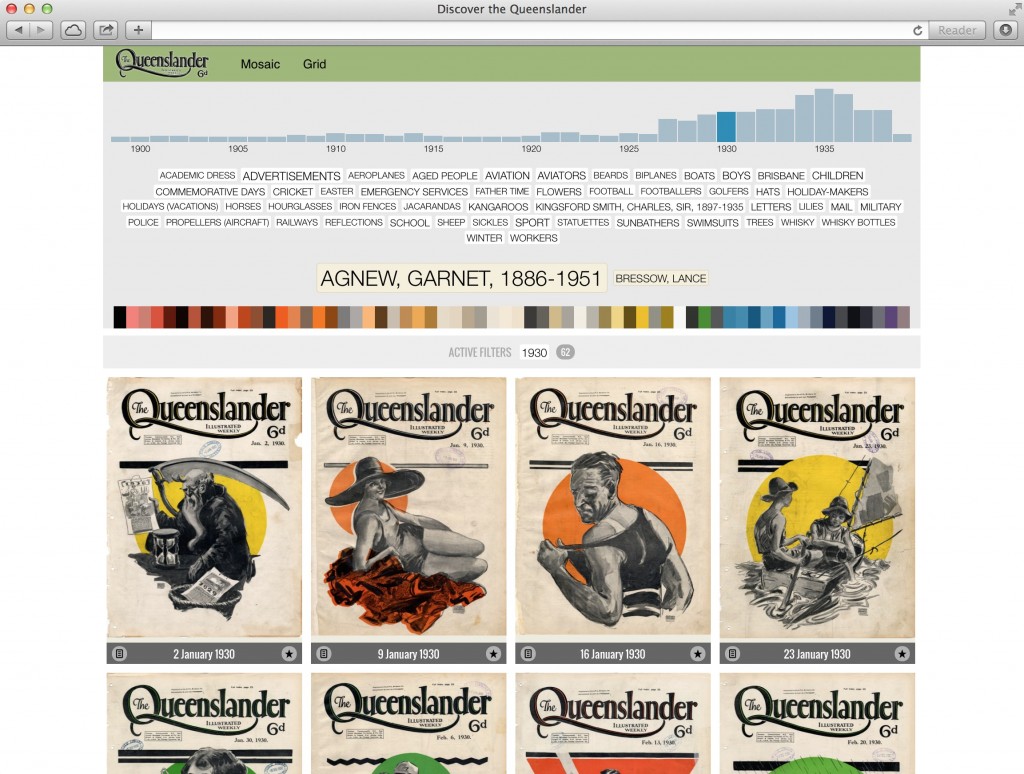In March 2014 I had the pleasure of presenting at the “Driving Forces” conference at the excellent ANU Art School. The conference bi-line: “The Role of Artists and Designers in Interdisciplinary Research” gives a pretty precise idea of what the conference was all about. Mitchell Whitelaw and I based our presentation on our experiences developing exploratory web interfaces for a beautiful collection of high res scans of “The Queenslander”, an early 20th century rural magazine. Our work was commissioned by the State Library of Queensland, a fantastic institution renowned for its progressive outlook regarding both physical and virtual manifestations of the modern library.

The conference, organised by Erica Seccombe, was really inspiring and we were fortunate to share our session with Nola Farman and Leah Heiss – I strongly recommend checking the work of both.
Our work, “Discover the Queenslander”, will be live on the SLQ site soon. Here is an abstract of our presentation…
An Interdisciplinary Machine: Reflections on Digital Practice-led Research
Mitchell Whitelaw and Geoff Hinchcliffe
Centre for Creative and Cultural Research
University of CanberraAbstract
In this paper we reflect on our own practice as designers, artists and programmers to argue that computation is a fertile site of interdisciplinarity, and software production is an inherently creative field ideally suited to practice-led enquiry.
Computation has been interdisciplinary since its inception; the earliest computing machines were used by physicists, meteorologists, cryptographers and biologists. Computation is in a sense indifferent to disciplines, reducible ultimately to a simple set of formal operations. This is not to reduce or dissolve disciplinary differences, but to create a common ground, a machine that in its indifference fosters connections between disparate domains. And computation is intrinsically pragmatic – it makes things happen, a verb, not a noun. It does not simply link different domains, but engages them in action, in joint projects and creations.
While code and programming have been professionalised and “disciplined” through computer science and software engineering, the explosion of the Web and its accessible programming languages drew broad participation in new forms of software production. Twenty five years later, we find computing at the heart of creative practice as evidenced by the Art+Code movement.
Our recent work with the State Library of Queensland demonstrates this interdisciplinary pragmatism in action. Our work relies on the practical affordances of both code and code culture: powerful software toolkits ready to be appropriated and recombined for novel outcomes. Data becomes a creative material as well as a shared language; in this project heritage collection data links us with the concerns and conventions of historians, librarians, archivists and information managers. Computation enables our joint project: creating rich new forms of exploration and engagement with digital collections. Computation also priveleges a practice-led approach. With code as a medium, we work through rapid ideation and experimentation towards an outcome that is only apparent in retrospect. We produce software, but we are not software engineers – rather we sketch, play, copy and paste; coding is a hands-on practice with its own pleasures and pitfalls, rather than a rationalised process. As artists and designers we respond to the specificity of each collection and the qualities of our materials; the solutions are bespoke, customised to each context but also produce generalisable knowledge.